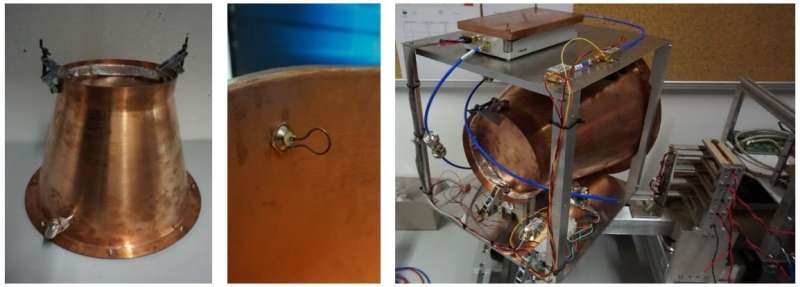May 23, 2018 report
Team tests feasibility of EmDrive and Mach Effect Thrusters

A team of German physicists with TU Dresden has independently tested the feasibility of the EmDrive and Mach Effect Thrusters. They have presented their findings at this year's Aeronautics and Astronautics Association of France's Space Propulsion conference.
The EmDrive is an experimental space engine design that came to light several years ago. It gained some prominence two years ago after NASA reported a team had been testing the engine to find out if it had merit. That team has not presented its findings, which led the team in Germany to test the idea for themselves.
The idea behind the EmDrive is simple—it is a hollow cone made of copper or other material and placed in a frame. Natural microwaves bouncing around inside the cone are supposed to provide thrust. If feasible, such an engine could push a rocket through space without the need to carry fuel. But as many physicists have pointed out, such an engine would defy the laws of physics as we know them. To test this concept anyway, the team in Germany built an EmDrive similar to the one NASA had looked at (a leaked paper offered some details), set it inside a highly shielded vacuum chamber and fired microwaves at it. They report that while the EmDrive did experience thrust, the thrust did not appear to come from the engine itself—there was thrust no matter which direction the engine was pointing, suggesting it originated from a secondary source, possibly magnetism from the Earth.
Mach Effect Thrusters have a stronger basis in known science, but are still considered to be an unlikely proposition. They are based on the idea that fluctuations generated in a piezo-crystal stack will create non-zero time-averaged thrust. The researchers in Germany built some for testing in their vacuum chamber, as well. They report that the results were more promising than for the EmDrive, but there is still not enough evidence to show such an idea might work. They found that the thrusters did provide thrust and they did it in the right direction. They also noted that thrust ceased when the thrusters were turned off. But they also found that the thrust produced was approximately 100 times more than was predicted by theory. Also, throwing the thrusters into reverse did not work, either. The researchers suggest there was likely an outside factor impacting the generated thrust.
More information: The SpaceDrive Project - First Results on EMDrive and Mach-Effect Thrusters, Conference: Space Propulsion Conference, At Seville, Spain , www.researchgate.net/publicati … ach-Effect_Thrusters
Abstract
Propellantless propulsion is believed to be the best option for interstellar travel. However, photon rockets or solar sails have thrusts so low that maybe only nano-scaled spacecraft may reach the next star within our lifetime using very high-power laser beams. Following into the footsteps of earlier breakthrough propulsion programs, we are investigating different concepts based on non-classical/revolutionary propulsion ideas that claim to be at least an order of magnitude more efficient in producing thrust compared to photon rockets. Our intention is to develop an excellent research infrastructure to test new ideas and measure thrusts and/or artefacts with high confidence to determine if a concept works and if it does how to scale it up. At present, we are focusing on two possible revolutionary concepts: The EMDrive and the Mach-Effect Thruster. The first concept uses microwaves in a truncated cone-shaped cavity that is claimed to produce thrust. Although it is not clear on which theoretical basis this can work, several experimental tests have been reported in the literature, which warrants a closer examination. The second concept is believed to generate mass fluctuations in a piezo-crystal stack that creates non-zero time-averaged thrusts. Here we are reporting first results of our improved thrust balance as well as EMDrive and Mach-Effect thruster models. Special attention is given to the investigation and identification of error sources that cause false thrust signals. Our results show that the magnetic interaction from not sufficiently shielded cables or thrusters are a major factor that needs to be taken into account for proper µN thrust measurements for these type of devices.
© 2018 Phys.org





















